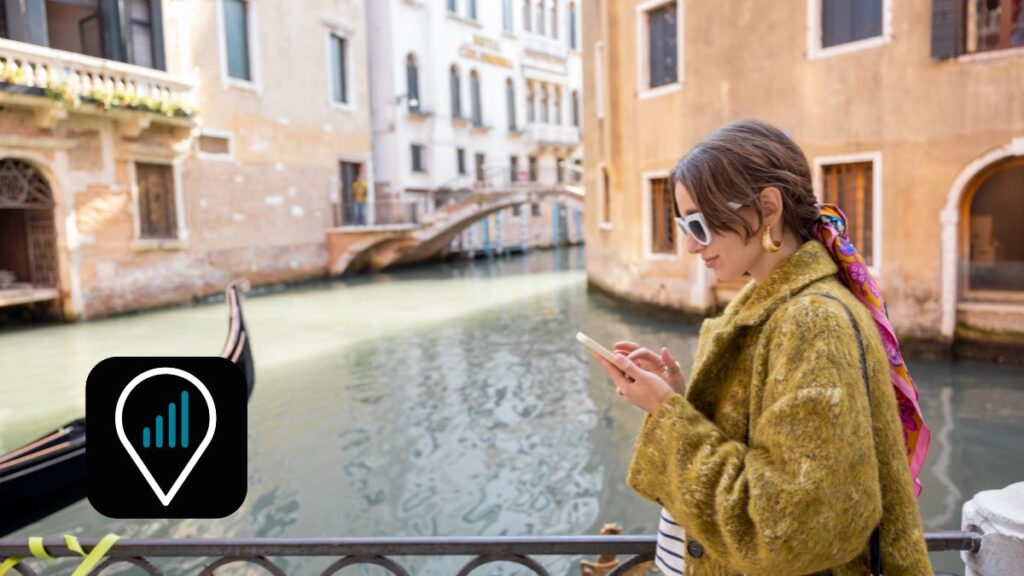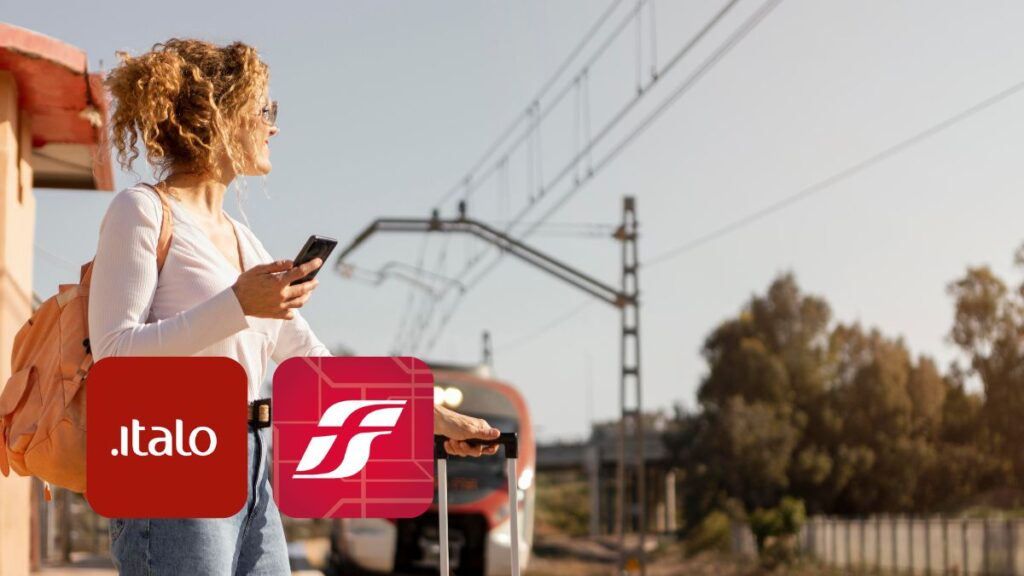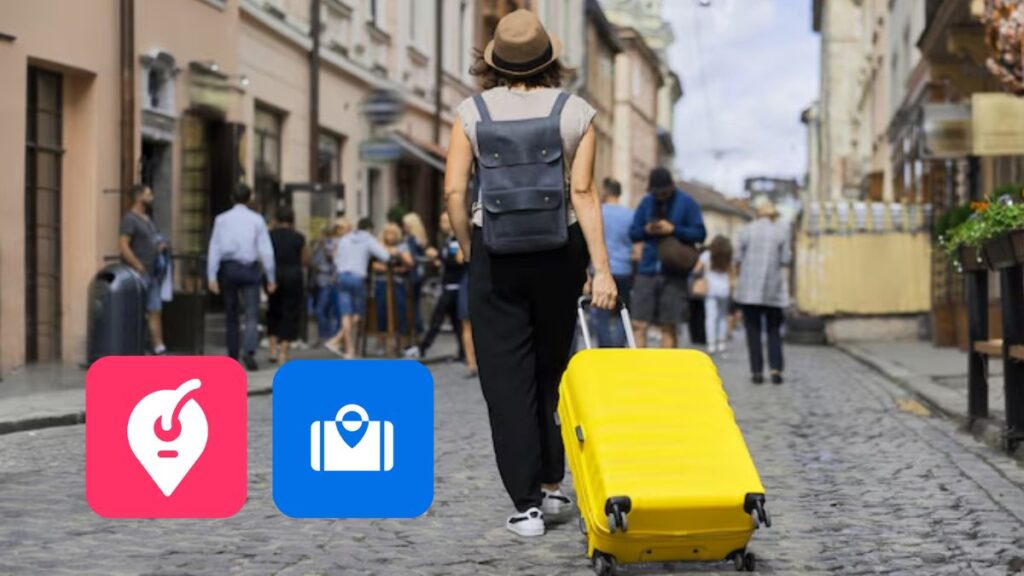Summary
- 1) Key Takeaways
- 2) 1. Stay Connected: Ubigi App for eSIM Data Plans
- 3) 2. Navigation: Google Maps & ViaMichelin
- 4) 3. Train & Public Transport: Trenitalia, Italo, & Moovit
- 5) 4. Taxi & Rideshare: Free Now & Uber
- 6) 5. Multi-Modal Travel: Rome2Rio & Omio
- 7) 6. Language Help: Google Translate & Duolingo
- 8) 7. Restaurant & Food Delivery: TheFork & Glovo
- 9) 8. Tours & Attractions: GetYourGuide & Viator
- 10) 9. Weather & Alerts: Il Meteo
- 11) 10.Luggage Storage: Nannybag & Stasher
- 12) Conclusion
- 13) Frequently Asked Questions
Key Takeaways
- Stay connected effortlessly in Italy with an eSIM data plan app like Ubigi — roaming fees, begone! Stay online for navigation and trip updates.
- Dependable direction is achievable with Google Maps and ViaMichelin, where you can tap into offline maps and find local eateries or control travel expenses.
- Booking and managing train or public transport is easy with apps like Trenitalia, Italo and Moovit, so it’s a breeze to get between cities and hop on local buses or trams.
- Free Now and Uber provide easy booking for taxis and ride-shares in the big cities so you can get around swiftly and securely.
- These apps make planning multi-modal journeys easier, as with Rome2Rio and Omio, which help you combine trains, buses, ferries, and cars for efficient travel across Italy.
- Spice up your trip with everything from translator apps to restaurant reservations to local weather and even secure luggage storage.

The best way to experience Italy vacation is with the right digital tools—especially apps for your trip that cover maps, bookings, and language. Some of the favorite Italy travel apps save time, show real-time train schedules, split bills, and help you discover incredible food spots.
With apps for public transport, translation, and local guides, your trip goes smoother. For fast advice on wifi, event tickets, and money exchange, these are our daily essentials and an essential part of any Italy guide.
This article “10 Essential Apps to Elevate Your Trip to Italy” will help you prepare your Italian trip without any stress !

1. Stay Connected: Ubigi App for eSIM Data Plans

Ubigi keeps you connected in Italy with lightning-fast eSIM data plans. With the Ubigi app, you get mobile data on your smartphone within minutes—no SIM tray hassles or hunting for local shops. Just make sure your device is eSIM-compatible.
iPhones and iPads work seamlessly, but always check your device list before traveling. You can purchase and activate your plan directly in the app, so you get instant connectivity whether you land in Rome or arrive by train in Florence.
Stay online for essentials like maps, ticket bookings, and sharing photos. With Ubigi, you avoid expensive roaming fees from your home provider. There’s no SIM swapping, your original number stays active, and you skip the risk of losing tiny SIM cards.
Prepaid plans mean you know exactly what you’re spending. Choose a 3GB data plan for a weekend in Milan or a 25GB data plan for a month-long adventure across Italy. Frequent travelers love Ubigi’s global convenience. It works in 200+ destinations, so you use the same app and process in many countries, saving time and hassle.
Some users find eSIM activation tricky at first, so it’s smart to set up a few days before departure while you still have home internet and access to customer support. Missing this step can lead to surprise roaming charges from your regular provider.
A little preparation goes a long way. Ubigi’s versatility covers you for quick trips or extended stays, making travel in Italy (and beyond) seamless and stress-free
2. Navigation: Google Maps & ViaMichelin

Google Maps and ViaMichelin stand out for their robust navigation features in Italy, whether you’re walking city streets or driving the countryside. Google Maps delivers clear pedestrian routes, turn-by-turn driving directions, and live public transport timetables—perfect for finding Florence’s hidden piazzas or Rome’s metro stops. Even in small towns or rural areas, you get reliable guidance and can avoid getting lost.
To dodge roaming fees or handle limited connectivity, both apps let you download offline maps in advance. This means you can search, plan routes, and view landmarks without burning through data… Even in the Tuscan hills or old Naples! Travelers love the security and freedom this provides, especially for walking in Venice or driving the Dolomites.
ViaMichelin offers extra perks: it highlights restaurants along your route, calculates fuel and toll costs, and lets you pick between toll, non-toll, fastest, shortest, or scenic routes. This helps with budgeting and discovering new food spots while traveling.
No app is flawless. Sometimes you’ll find outdated road info or speed limits, so it’s smart to double-check with local signs. Google Maps’ community updates can be helpful for real-time changes. Most navigation apps need an internet connection for live updates, making offline maps a valuable backup.
Try both apps to see which fits your style: many prefer Google Maps for walking and public transport, while others love ViaMichelin for detailed road trips and cost planning.
3. Train & Public Transport: Trenitalia, Italo, & Moovit

Trenitalia and Italo put Italy’s train network at your fingertips, making it easy to book tickets for high-speed routes between major cities like Rome, Florence, and Milan, as well as regional journeys to smaller towns.
Trenitalia is the national rail provider, covering the widest network and offering schedules, prices, seat selection, and delay notifications in its app. Italo focuses on fast trains and often has exclusive deals, with many travelers finding its app quick and convenient. It’s especially true for last-minute bookings. While Trenitalia serves more destinations, Italo is often cheaper on high-speed routes and both offer comfortable, reserved seating.
Booking online through either app lets you skip ticket lines and keep everything digital. Just show your e-ticket on your phone for boarding. This is handy for both high-speed trips, like Venice to Rome, and regional routes to coastal towns. Some users report Trenitalia’s app can be less reliable in certain cities, so having both apps ensures you’re covered if one fails.
For city transport, Moovit is a top choice. It provides live updates, turn-by-turn directions, and real-time arrival times for buses, trams, and metros in cities like Milan, Florence, and Rome. Travelers find Moovit more reliable than local apps, especially for up-to-date schedules.
Having all three apps – Trenitalia, Italo, and Moovit – means you’re ready for everything from cross-country train rides to daily commutes in Italy’s cities.
4. Taxi & Rideshare: Free Now & Uber

Free Now and Uber make it easy to hail taxis in major Italian cities like Rome, Milan, and Florence. With Free Now, you can quickly book a licensed taxi, skip long lines, and pay by card or cash, all while tracking your ride and seeing the fare upfront. Uber operates mainly as Uber Black in Italy, offering luxury vehicles with professional chauffeurs, but it’s available in fewer cities and is typically much pricier than regular taxis.
Both apps are especially handy for airport transfers and city rides, plugging you directly into the local taxi network. Italian taxi drivers know the cities well, so you’re in good hands for shortcuts and local tips. Free Now is widely used and reliable, with flexible payment options and the ability to rate your experience.
Ride-sharing regulations in Italy are strict, and conventional taxis dominate the market, so you may find fewer ride-share options than in other countries and longer waits, especially late at night or in smaller towns. Still, Free Now remains a top choice for tourists and locals alike, while Uber Black is ideal for those seeking extra comfort or privacy.
A fun bonus: some apps, including Free Now, offer scooter rides in cities like Rome and Florence, letting you zip through traffic like a local. For the best experience, it’s smart to have both apps on your phone and check availability depending on your location and needs.
5. Multi-Modal Travel: Rome2Rio & Omio

Multi-modal travel planning is made easy with apps like Rome2Rio and Omio, which let you plan routes across Italy by train, bus, ferry, or car in just a few taps. These apps are especially useful for complex itineraries, such as visiting multiple cities or combining different transport types. For example, if you want to travel from Florence to the Amalfi Coast, Rome2Rio details every step, showing train times, bus routes, and ferries as needed. You can easily compare trip lengths and ticket prices in one place.
All you need is a mobile or Wi-Fi connection to access these platforms, whether you’re in a hotel, café, or at a station. This is a major benefit for tourists unfamiliar with Italian transport or the language, as it reduces travel stress. Both Rome2Rio and Omio display connections and schedules in a clear, user-friendly layout, so there’s no need to jump between different company websites.
With these apps, you can view all your options before choosing what fits your schedule and budget. No more hesitation between fast trains, local buses, car rentals. They excel at intercity travel: for instance, traveling from Milan to Venice is simplified with breakdowns of train, bus, and car-share options, including estimated prices and travel times.
You can select the quickest or cheapest route and buy tickets directly within the app, which is especially helpful when mixing modes, like high-speed and regional trains or a bus for the final leg. Both apps support booking for travel between large cities and smaller towns, and even show metro, bus, and tram options for city trips. Their streamlined interfaces and current schedules make them reliable for planning both in advance and for last-minute changes.
6. Language Help: Google Translate & Duolingo

Google Translate offers instant assistance for deciphering Italian menus, signs, or fast-paced conversations. Simply aim your camera at a menu to see the English translation on your phone, or type in a word or phrase for an immediate definition and pronunciation.
The app’s two-way speech translation lets you communicate with shopkeepers, order food, or ask for directions. You can also scribble or spell out words as an alternative. While speech recognition may sometimes struggle in noisy places, Google Translate covers most traveler needs for navigating the local language.
A major advantage is the ability to download the Italian language pack for offline use. This means you can translate menus at a rustic trattoria, read museum plaques, or understand street directions even without internet access. It’s ideal when Wi-Fi or mobile data is unreliable. The offline mode is especially useful outside big cities or on long train rides.
Duolingo is another excellent tool for learning Italian basics before or during your trip. Its bite-sized lessons focus on reading, listening, and speaking, letting you pick up useful phrases while waiting for a bus or on a plane. Duolingo helps you learn practical travel phrases and greetings, and you can improve further by pairing it with audio CDs or podcasts.
Most travelers find that combining apps offers the best chance to learn and use Italian while traveling. Switch between Duolingo, Google Translate, and others to get the best transation. While there may be occasional issues with numbers or pronunciation, repeating drills and hearing native speakers in the app help you practice and improve.
7. Restaurant & Food Delivery: TheFork & Glovo

TheFork is a leading restaurant reservation app in Italy, offering fast access to thousands of gelaterie and top restaurants, from classic trattorias to trendy spots in Rome, Milan, and Florence.
With TheFork, you can browse menus, ratings, and prices directly on your phone, making it easy to choose where to eat. Features like Nearby Restaurants help you find places close to your hotel or attractions, while filters let you select by cuisine. Pizza, seafood, vegan, and more : pick according to your mood. The Cool Areas feature organizes eateries by neighborhood, perfect for planning meals near must-see sites.
Booking is simple: just enter your name, date, time, group size, and phone number. Some restaurants may call to confirm, so watch for Italian numbers. The app eliminates the need for awkward phone calls, making it ideal if you don’t speak Italian. While coverage is strongest in major cities, TheFork still provides helpful suggestions based on location, cuisine, or popularity, and often offers exclusive discounts for app users.
Glovo is a popular food delivery app in Italy, delivering from local pizzerias, gelaterias, and even Michelin-starred kitchens. You can also order groceries, snacks, and household goods, which is convenient after a long day. Glovo operates in many Italian cities, supporting both delivery and takeaway. It’s ideal if you prefer to dine in your hotel or Airbnb. The app lets you track your order live, see estimated delivery times, and pay securely.
Both TheFork and Glovo make mealtimes in Italy stress-free, helping you discover new flavors whether you’re dining out or staying in.
8. Tours & Attractions: GetYourGuide & Viator

GetYourGuide and Viator are top apps for booking tours, museum passes, and skip-the-line tickets. A must have when visiting Italy’s most iconic sites, including the Colosseum and Uffizi. These platforms offer a wide range of local experiences with live availability, reviews, and transparent pricing before you book. Think pasta-making classes in Rome and gondola rides in Venice!
You can browse by location, interest, or tour style. With these apps, find everything from walking tours and day trips to exclusive after-hours access at busy attractions. Both apps provide detailed information about each experience, including meeting points, guides, and what’s included. You will know what to expect. Booking and payment are simple, with support for multiple languages and currencies.
Many travelers prefer these apps for their convenience and safety. They streamline booking and often offer unique itineraries tailored to your schedule, budget, and group size. You can read comprehensive reviews from fellow travelers, helping you choose the best experience for your trip.
However, it’s important to check refund and cancellation policies before you pay. Some bookings require cancellations within a set window for a refund. Experiences with rescheduling or customer support can vary. Sometimes direct bookings with tour operators offer more flexibility for last-minute changes.
For most, the ease and variety of GetYourGuide and Viator make them essential travel tools. Always double-check the terms to avoid surprises if plans change.
9. Weather & Alerts: Il Meteo

Il Meteo gives you local weather forecasts and real-time alerts for every area of Italy. It’s a reliable weather sidekick for travel. You get forecasts for all Italian communes and hundreds of tourist destinations. Whether you’re in Florence or hiking Lake Garda, you know what to expect.
Il Meteo covers more than Italy. You find detailed weather for thousands of European and international cities. This is useful if you travel from Rome to Paris or beyond.
Checking the weather is quick with the app’s widget and webcam section. See current conditions on your home screen. Webcams show live snapshots from select locations. You can view if rain clouds are over Venice or if Palermo is sunny. You get a live feed, not just an icon.
A standout feature is hourly rain predictions. These alert you in advance and help avoid weather surprises. You can plan for a raincoat or pick a beach day. Many users rely on Il Meteo to avoid sudden weather shifts. The app sends real-time warnings with photos and videos from users. You see the situation firsthand.
When storms hit Milan, you get advance warnings and visual proof. This helps you change plans quickly and stay safe. Each day’s forecast has a circle symbol showing probability. You know if you can trust the sun or need a Plan B.
Il Meteo offers a dark mode for night or low light use. The design is minimal and clean, focusing on key information. You see clear weather data and daily temperature trends to help you pack and plan.
For air quality, the app gives an AQI with interactive pollutant info. You see levels for PM10 or ozone—handy for allergies or outdoor plans.
10.Luggage Storage: Nannybag & Stasher

Nannybag and Stasher let you drop your bags near train stations or main sights. You can walk around hands-free and stress-free. Both services connect you to secure locations for your bags. You pick a spot that fits your itinerary.
In Rome, drop bags near Termini Station or the Colosseum. Milan and Florence offer coverage near main museums and piazzas. The network is extensive—over 7,000 city locations. You’ll usually find one nearby, even for last-minute plans.
You get peace of mind because partners are verified in person. Only trusted shops or hotels are used. Many providers include insurance, sometimes up to £3,000 per bag. This protects you if something unexpected happens, especially with valuable items.
Many users check Trustpilot ratings before booking. Ratings of 4.2/5 or higher are common, so you can trust the service. If you need help, 24/7 support teams are ready to assist. There are no weight restrictions—stash backpacks, suitcases, or large equipment.
Prices vary by location. Daily rates start around $5-$6 per bag. Tourist areas or big cities may cost more. Some providers use dynamic pricing, so rates can change with demand.
You can find discounts by booking ahead or choosing quieter spots. Most offer 10% off for first-timers or deals during high season. Always check active promos before you book to save more.
Nannybag and Stasher help you maximize travel days with late flights or time after check-out. No need to lug bags through busy streets. Enjoy one last museum, meal, or walk instead. These apps make your Italy trip smoother and more relaxed.
Conclusion
With the appropriate apps, your trip to Italy just glide along. Nice maps like Google Maps or ViaMichelin keep you going. Train apps display live rides. Call a cab or hunt down a bus in a few taps. Food is a breeze with TheFork or Glovo. Quick tools like Google Translate bulldoze language walls. You check the weather, book tours, or stow your bags with ease.
These apps save you time and show more, especially in urban cities where navigation and bookings are constant. You get easy access to everything from street maps to restaurant reviews. Many are optimized for both Android users and Apple iOS, making them widely available. Whether you’re visiting Rome or hopping small towns, they’re designed to support your travel flow.
You get uncluttered decisions, safe strides and less bruising. Some even link to travel insurance providers for peace of mind. You can save your favorite places within the apps to revisit later or share with friends. Choose the ones that match your style. Maximize your days in Italy. Give these apps a shot and let your trip go easy and smart.

Frequently Asked Questions
Do I need an Italian SIM card to use these apps?
No, you don’t need a SIM card. If you need to get connected, use Ubigi’s app to purchase an eSIM data plan (works in Italy). It keeps you online without the hassle of buying a local SIM.
Can I use Google Maps offline in Italy?
Absolutely, you can save offline maps in Google Maps pre-trip. Not only this, but when you’re offline, it aids your way through Italian cities and towns.
Are these apps available in English?
Most of these apps like Trenitalia, Moovit, and TheFork have English language options. So they’re simple for you to use, even if you don’t speak Italian.
How can I book train tickets in Italy?
Use the Trenitalia or Italo apps to check schedules and book train tickets. Both take international payment methods and display real-time route and price information.
Is it safe to use rideshare apps like Uber in Italy?
Yes, Uber and Free Now are very safe to use in Italy. For additional protection, be sure to confirm the driver and car information in the app prior to beginning your ride.
Can I use these travel apps in smaller Italian towns?
A number of these apps, such as Google Maps and Moovit, function in the majority of Italian towns. Glovo and Uber may be confined to bigger cities, so confirm whether they’re available in your area.
How do I store my luggage safely while sightseeing?
Nannybag or Stasher can find you secure luggage storage spots in Italian cities. Book online, drop off your bags and roam worry-free!





